
Barn Owl Pictures - Paintings in Progress
View how a piece of artwork is developed
BARN OWL PICTURES
Previously "On the Easel"
Welcome - wildlife paintings in progress by Martin Ridley. These barn owl pictures were previously featured "On the Easel".
Follow an oil painting demonstration, see how a piece of artwork evolves from the initial drawings through to completion. Here are some barn owl working drawings to show how I experiment and make minor adjustments until I'm happy with the results. View the stages of the drawings as they develop towards the finished picture.
PREVIOUSLY FEATURED "ON THE EASEL"
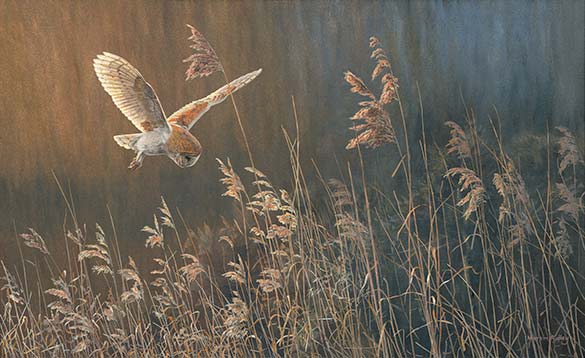
"Over the Reeds" Barn Owl in Flight
Original oil painting
image 22 x 36 inches
£5950 For Sale Currency Converter
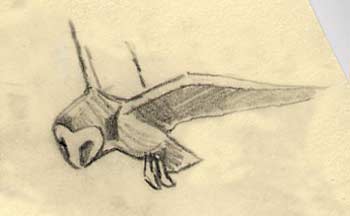 When working up preparatory drawings in the studio there are some shortcut methods that I use to create a strong image.
When working up preparatory drawings in the studio there are some shortcut methods that I use to create a strong image.
I frequently overlay preliminary sketches with fresh sheets of paper on a light box to redraw the positive lines developed so far.
This enables me to efficiently preserve the best elements and focus on the problems.
While developing a preparatory drawing areas that aren't working are covered up. Fresh pieces of paper with improvements are taped on until the image comes together.
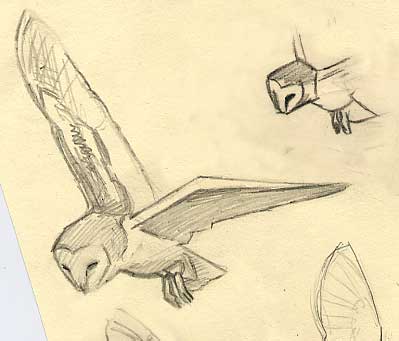
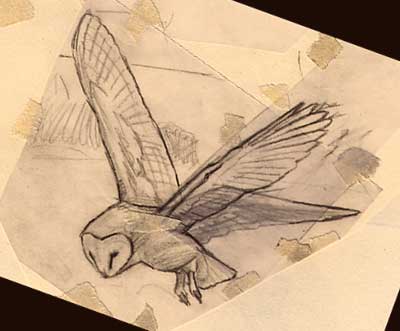
Barn Owl Sketches, (Tyto Alba)
In the studio I have gathered many sources of reference material to help me understand the finer details of the owl, which include:
- preserved wings and feathers collected from various dead birds that I have found.
- filed images; magazine clippings, photos and previous drawings.
- simple models that I've made to help understand a form in 3D or work out shadows.
Knowledge is the key to my working methods:
- knowledge of the animal and its behaviour in its natural habitat. (I only really like to paint animal species, which I have studied in the wild)
- knowledge gained by research
Confidence develops through an understanding of an animal species and allows extra creative freedom.
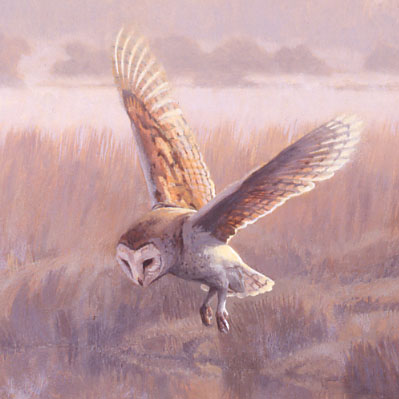
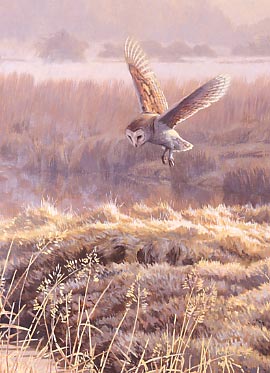 Hovering Barn Owl
Hovering Barn OwlDetails from the original oil painting
image 30 x 24 inches
Original Sold
PREVIOUSLY FEATURED "ON THE EASEL"
View more painting demonstrations
Shop Items
Barn Owl Cards for Sale
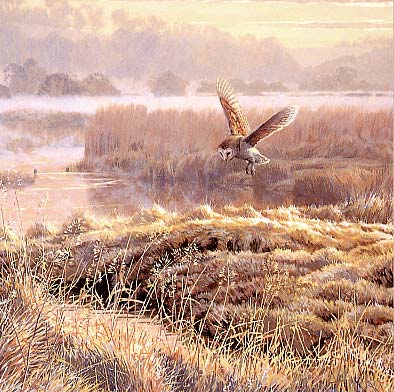
Barn Owl Facts
The Barn Owl (Tyto alba) is the most widely distributed species of owl, and one of the most widespread of all birds. The Barn Owl is a pale, long-winged, long-legged owl with a squarish tail. Barn Owl are 33–39 cm in length with an 80–95 cm wingspan. The face is a pale heart shape. The rest of their head and upperparts are buff with fime mottling, and the underparts are white. They hunt by flying low and slowly over an area of open ground, hovering over spots that conceal potential prey.
Owls do not require sight to hunt they have phenomenal hearing. They can target and dive down to sink their talons through snow or grass and seize prey with deadly accuracy. Compared to other owls of similar size, the Barn Owl has a much higher metabolic rate, requiring relatively more food. Pound for pound, they consume more rodent pests than possibly any other creature. This makes the Barn Owl one of the most economically valuable wildlife animals to farmers. Farmers find these owls more effective than poisons, and they often encourage Barn Owls to stay around by providing nest sites.
DIET
The Barn Owl feeds primarily on small vertebrates, particularly rodents, some birds and insects. Small bats and reptiles may also be taken in some locations. Studies have shown that an individual Barn Owl may eat one or more rodents per night; a nesting pair and their young can eat more than 1000 rodents per year.
DISTRIBUTION
The Barn Owl is a bird of open country, such as farmland, preferring to hunt along the edges of woods. It is one of the most widespread vertebrate species on Earth, occurring on every continent except Antarctica. It is absent from most of Canada and Alaska, as well as Greenland, most of central and eastern Asia, the Sahara Desert, New Zealand, and some Pacific islands.
BREEDING
Barn owls can breed when they are one year old. 4 - 6 eggs are incubated for about 32 days by the female. The young fledge at 53 - 61 days.
More about Barn Owls via EXTERNAL LINKS
Barn Owl (Fact Sheet from the RSPB)
Barn Owl (BTOweb BirdFacts)



